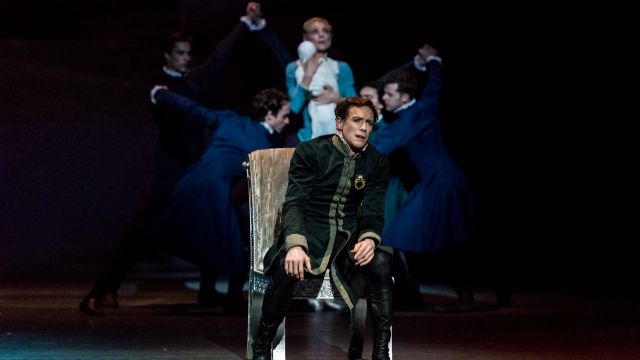The Winter’s Tale
Christopher Wheeldon’s ballet of Shakespeare’s The Winter’s Tale has already been claimed a “modern classic” and last night the Royal Ballet showed just how good his adaptation is. One of the last plays Shakespeare ever wrote, it deals with the destructive power of jealousy and the redemptive power of love.
It’s a difficult mix of tragedy in the first act, frivolity in the second, and magic-realism in the third. Wheeldon’s vision, which stripped the drama back to basics, was always clearly articulated, in an evening of superb narrative dance which was complimented by Joby Talbot’s specially commissioned score, Bob Crowley’s beautifully imaginative sets (especially his floating tree), Natasha Katz’s atmospheric lighting, and spectacular video projections and billowing silks that represented everything from hazardous sea voyagers, storms, and the most famous stage direction in all of Shakespeare: “…exit, pursued by a bear,” which became a marvellously inspired effect.
 As the mad Leontes, Edward Watson was simply stunning in his psychotic moods of jealousy and physically violent rages. A brilliant expressive dancer, the anguish and pain of his unfounded fear of his wife’s infidelity were acutely revealed in a tour de force performance. Lauren Cutherbertson’s Hermione was nicely layered; exuberant in love, joyful in pregnancy, and horror-stricken when accused of adultery and treason, whilst Zenaida Yanowsky’s Head of Household Paulina gave the character dimension in a breathtaking portrayal of grace, loyalty and passion. Tall and sinewy, she was an eloquent jewel when ever she was on stage. As Leontes best friend and the one who incurred his adultery accusations, Federico Bonelli’s Polixenes, King of Bohemia, had a strident and commanding presence. Steven McRae and Francesca Hayward as the lovers Florizel and Perdita, dominated the second act with their bravura dancing; McRae with his amazing leg extensions and leaps, and Hayward with her exquisite work en-pointe.
As the mad Leontes, Edward Watson was simply stunning in his psychotic moods of jealousy and physically violent rages. A brilliant expressive dancer, the anguish and pain of his unfounded fear of his wife’s infidelity were acutely revealed in a tour de force performance. Lauren Cutherbertson’s Hermione was nicely layered; exuberant in love, joyful in pregnancy, and horror-stricken when accused of adultery and treason, whilst Zenaida Yanowsky’s Head of Household Paulina gave the character dimension in a breathtaking portrayal of grace, loyalty and passion. Tall and sinewy, she was an eloquent jewel when ever she was on stage. As Leontes best friend and the one who incurred his adultery accusations, Federico Bonelli’s Polixenes, King of Bohemia, had a strident and commanding presence. Steven McRae and Francesca Hayward as the lovers Florizel and Perdita, dominated the second act with their bravura dancing; McRae with his amazing leg extensions and leaps, and Hayward with her exquisite work en-pointe.
Alondra de la Parra and the Queensland Symphony Orchestra dynamically brought Talbot’s thematically colourful score to life which at times was reminiscent of Bernstein, and at others of a cinematic soundscape. The solo violin opening to the third act was hauntingly beautiful, likewise the renaissance-type folk music which captured the bucolic gaiety of the second act’s May Queen Festival with onstage musicians playing a dulcimer, accordion, bansuri and percussion. Crowley’s visual motif of stone statues not only enhanced the stage design but also seamlessly tied the first and third acts together.
The ballet world is not short of story ballets but new ones that work are a rare breed. This is one of them. Christopher Wheeldon is to be congratulated, the Royal Ballet are to be congratulated, and balletomanes the world over can rejoice. It is indeed a “modern classic.”
Peter Pinne
Subscribe to our E-Newsletter, buy our latest print edition or find a Performing Arts book at Book Nook.

